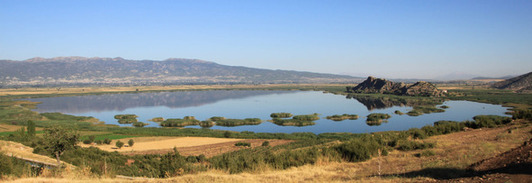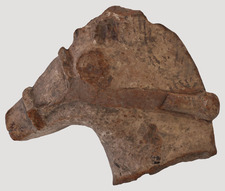"Old-Kibyra"

One of the three sites chosen for our intensive survey is situated on a rocky peninsula projecting into Lake Gölhisar. During the campaigns of 2009 to 2011 we focussed on a large, but nearly completely destroyed settlement, which we have identified as “Old-Kibyra”. While the architectural remains are in a poor condition, the pottery sherds found in large quantities on the peninsula and nearby, as well as the extensive necropolis and the densely populated hinterland point to a function as a ‘Zentralort’ (‘central place’) of this settlement during the pre-Hellenistic and especially Archaic period. Among the pottery fragments are numerous imports reflecting the geographic position of the region. Furthermore, the head of a small terracotta figurine probably belonging to a quadriga (s. fig.), the fragment of a limestone bird sculpture, as well as architectural terracottas attest the existence of a sanctuary on the peninsula of an, at least, regional importance. Moreover, the numerous, although badly destroyed, tumuli discovered by us on the slopes south of Gölhisar Gölü may be connected to the Lydian background of the settlement attested by Strabo. At some of these tumuli we found those mushroom- or phallus-shaped gravemarkers (cippi) characteristic especially for the tumuli of the Lydian and Ionian regions. Against this background the identification of the settlement with the ancient site of Sinda suggested by Alan Hall in the 1980s seems to be obsolete.
the pottery sherds found in large quantities on the peninsula and nearby, as well as the extensive necropolis and the densely populated hinterland point to a function as a ‘Zentralort’ (‘central place’) of this settlement during the pre-Hellenistic and especially Archaic period. Among the pottery fragments are numerous imports reflecting the geographic position of the region. Furthermore, the head of a small terracotta figurine probably belonging to a quadriga (s. fig.), the fragment of a limestone bird sculpture, as well as architectural terracottas attest the existence of a sanctuary on the peninsula of an, at least, regional importance. Moreover, the numerous, although badly destroyed, tumuli discovered by us on the slopes south of Gölhisar Gölü may be connected to the Lydian background of the settlement attested by Strabo. At some of these tumuli we found those mushroom- or phallus-shaped gravemarkers (cippi) characteristic especially for the tumuli of the Lydian and Ionian regions. Against this background the identification of the settlement with the ancient site of Sinda suggested by Alan Hall in the 1980s seems to be obsolete.
Despite the poor preservation of the site, which is also the result of excessive overbuilding during the late medieval and early modern periods followed by a nearly complete destruction around 1700, we decided to map the settlement remains in 2009 and 2010. The plan will be part of the first volume of the publication of our research in the Kibyratis. A first impression of the settlement is given in our annual preliminary reports as well as in a detailed report in the current issue of Istanbuler Mitteilungen (Vol. 62, 2012).

